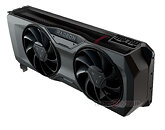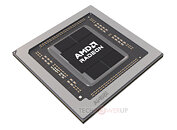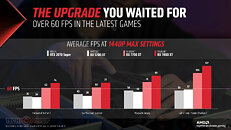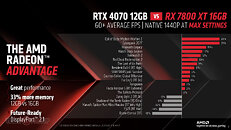- Joined
- Oct 9, 2007
- Messages
- 47,655 (7.43/day)
- Location
- Dublin, Ireland
| System Name | RBMK-1000 |
|---|---|
| Processor | AMD Ryzen 7 5700G |
| Motherboard | Gigabyte B550 AORUS Elite V2 |
| Cooling | DeepCool Gammax L240 V2 |
| Memory | 2x 16GB DDR4-3200 |
| Video Card(s) | Galax RTX 4070 Ti EX |
| Storage | Samsung 990 1TB |
| Display(s) | BenQ 1440p 60 Hz 27-inch |
| Case | Corsair Carbide 100R |
| Audio Device(s) | ASUS SupremeFX S1220A |
| Power Supply | Cooler Master MWE Gold 650W |
| Mouse | ASUS ROG Strix Impact |
| Keyboard | Gamdias Hermes E2 |
| Software | Windows 11 Pro |
AMD today at Gamescom unveiled the Radeon RX 7800 XT and Radeon RX 7700 XT performance-segment graphics cards. Designed for maxed out gaming at 1440p with ray tracing, the two are designed to square off against NVIDIA's GeForce RTX 4070 series, offering competitive performance and pricing. The two are based on AMD's latest RDNA3 graphics architecture, and use the 5 nm foundry process where it matters. Both cards claim to offer not just superior performance to the specific NVIDIA RTX 40-series SKUs they're designed to compete with, but also better future-proofing, with more video memory on offer.
At the heart of the two is the new "Navi 32" GPU, AMD's second largest chip from this generation. It is a chiplet GPU, just like the "Navi 31" that powers the RX 7900 series, albeit slightly scaled down. The graphics compute die (GCD), the die with the main graphics rendering and compute machinery, is built on the 5 nm EUV foundry node. It is flanked by four memory cache dies (MCDs), each built on the 6 nm foundry node. These are the same MCDs found in the "Navi 31," but four in number instead of six, which gives the "Navi 32" a 256-bit wide GDDR6 memory interface.





The Radeon RX 7800 XT maxes out the "Navi 32," enabling all 60 compute units (CU) physically present, which works out to 3,840 stream processors, 120 AI accelerators, 60 Ray accelerators, 64 MB of Infinity Cache, and 16 GB of GDDR6 memory across the chip's full 256-bit memory interface. The GPU ticks at 2124 MHz Game clocks, and 2430 MHz boost; while its memory runs at 19.5 Gbps, resulting in 624 GB/s of memory bandwidth. The card is configured with 263 W of total board power, and its reference design comes with two 8-pin PCIe power connectors.

The Radeon RX 7700 XT is cut down from the same "Navi 32" silicon as the RX 7800 XT, and uses the same reference board design. The biggest change here, is that the memory size is reduced to 12 GB, the Infinity Cache to 48 MB, and the memory bus width to 192-bit. One of the four MCDs on the "Navi 32" silicon is disabled. Over on the GCD, the RX 7700 XT is configured with 54 CU, which works out to 3,456 stream processors, 108 AI accelerators, 54 Ray accelerators, and 180 TMUs. The GPU runs at higher clock speeds than the RX 7800 XT, with 2171 MHz Game clocks, and 2544 MHz boost. The memory speed, however, is lower, at 18 Gbps, which over the 192-bit memory interface, puts out 432 GB/s of bandwidth. The RX 7700 XT is configured with 245 W of total board power, and has the same dual 8-pin power input setup as the RX 7800 XT.




In terms of performance, AMD claims that the Radeon RX 7800 XT offers anywhere between 2% to 23% performance gains over the GeForce RTX 4070 in 13 of the 19 games they tested. Testing was done at 1440p with max settings for each game. AMD also claims that the extra 4 GB of memory should give you better future-proofing. The Radeon RX 7700 XT, on the other hand, is shown scoring anywhere between 1% and 31% higher than the GeForce RTX 4060 Ti 16 GB, in 16 out of 19 games that the two cards were compared in.
The reason AMD chose the RTX 4070 and RTX 4060 Ti 16 GB for comparisons, is because it intends to price the RX 7800 XT and RX 7700 XT competitively to them. The Radeon RX 7800 XT is priced at USD $499, while the RX 7700 XT is priced at $449. Both cards go on sale from September 6, 2023.
View at TechPowerUp Main Site
At the heart of the two is the new "Navi 32" GPU, AMD's second largest chip from this generation. It is a chiplet GPU, just like the "Navi 31" that powers the RX 7900 series, albeit slightly scaled down. The graphics compute die (GCD), the die with the main graphics rendering and compute machinery, is built on the 5 nm EUV foundry node. It is flanked by four memory cache dies (MCDs), each built on the 6 nm foundry node. These are the same MCDs found in the "Navi 31," but four in number instead of six, which gives the "Navi 32" a 256-bit wide GDDR6 memory interface.





The Radeon RX 7800 XT maxes out the "Navi 32," enabling all 60 compute units (CU) physically present, which works out to 3,840 stream processors, 120 AI accelerators, 60 Ray accelerators, 64 MB of Infinity Cache, and 16 GB of GDDR6 memory across the chip's full 256-bit memory interface. The GPU ticks at 2124 MHz Game clocks, and 2430 MHz boost; while its memory runs at 19.5 Gbps, resulting in 624 GB/s of memory bandwidth. The card is configured with 263 W of total board power, and its reference design comes with two 8-pin PCIe power connectors.

The Radeon RX 7700 XT is cut down from the same "Navi 32" silicon as the RX 7800 XT, and uses the same reference board design. The biggest change here, is that the memory size is reduced to 12 GB, the Infinity Cache to 48 MB, and the memory bus width to 192-bit. One of the four MCDs on the "Navi 32" silicon is disabled. Over on the GCD, the RX 7700 XT is configured with 54 CU, which works out to 3,456 stream processors, 108 AI accelerators, 54 Ray accelerators, and 180 TMUs. The GPU runs at higher clock speeds than the RX 7800 XT, with 2171 MHz Game clocks, and 2544 MHz boost. The memory speed, however, is lower, at 18 Gbps, which over the 192-bit memory interface, puts out 432 GB/s of bandwidth. The RX 7700 XT is configured with 245 W of total board power, and has the same dual 8-pin power input setup as the RX 7800 XT.




In terms of performance, AMD claims that the Radeon RX 7800 XT offers anywhere between 2% to 23% performance gains over the GeForce RTX 4070 in 13 of the 19 games they tested. Testing was done at 1440p with max settings for each game. AMD also claims that the extra 4 GB of memory should give you better future-proofing. The Radeon RX 7700 XT, on the other hand, is shown scoring anywhere between 1% and 31% higher than the GeForce RTX 4060 Ti 16 GB, in 16 out of 19 games that the two cards were compared in.
The reason AMD chose the RTX 4070 and RTX 4060 Ti 16 GB for comparisons, is because it intends to price the RX 7800 XT and RX 7700 XT competitively to them. The Radeon RX 7800 XT is priced at USD $499, while the RX 7700 XT is priced at $449. Both cards go on sale from September 6, 2023.
View at TechPowerUp Main Site





